
By Tiana Hall
Governor's Intern
Chapter Six
After the War
World War I ended on November 11, 1918, and the Allies, including France, Great Britain, Russia, Italy, Japan, and the United States, won the war. Organizations such as the reunion for the 80th Division of Veterans were created to give veterans a sense of refuge and solidarity, while organizations such as the Gold Star Mothers helped mothers cope with the grief of losing their sons in war. Memorials were also built to honor both Caucasian and African American soldiers from West Virginia. Through these organizations and memorials, the stories of World War I live on.

Menu, 1st Reunion of Battery A,
314th Field Artillery, in Wheeling, February 21, 1921
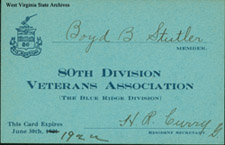
Membership Card for Boyd Stutler, 80th Division Veterans Association. All images from the Boyd B. Stutler Collection
|
The 80th Division Association was organized in France in March of 1919 and the national reunion for the 80th Division of Veterans, held in Charleston, West Virginia, in 1922. Gilmer County native Boyd Stutler helped organize the association. Stutler, who volunteered to serve as an army private during World War I, did his training at Camp Lee, Virginia, in 1917 and was assigned to Battery A, 314th Field Artillery Regiment, 80th Infantry Division. He was promoted to corporal on December 1, 1917 and then to sergeant on March 9, 1918. He was again promoted to regimental personnel sergeant on May 1, when he was transferred to Headquarters Company, 314th Field Artillery. On May 26, 1918, he arrived in France and remained there for a year with the American Expeditionary Force. While in France, he fought in both the St. Mihiel and the Meuse-Argonne Offensive and also served in the defensive sector in Verdun. After the war, Stutler not only helped start the reunion for 80th Division of Veterans,1 but he was also a member of the American Legion, an association of former U.S. servicemen formed in 1919,2 and was a member of the Charleston Chapter of the Red Cross, an international humanitarian organization that provides relief to victims of war or natural disaster.3
|

Ribbon. |
|
Although he was a veteran of World War I, he had many other great accomplishments including being the editor of the American Legion magazine in 1936 and serving as a correspondent for the Legion in the South Pacific during World War II. He also was a collector of Civil War items and an expert on John Brown, an abolitionist, who led an armed slave rebellion in Harpers Ferry, Virginia (West Virginia), in 1859.4 Despite only having a sixth-grade education, Stutler was regarded as a renowned historian, giving Civil War lectures to Yale and Princeton. He was also an acclaimed writer of West Virginia Casualties in the War with Germany and Captain John Brown and Harper's Ferry and co-wrote West Virginia Yesterday and Today, a textbook used in West Virginia Studies classes in middle and junior high schools.5 |
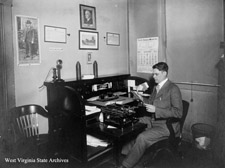
Boyd B. Stutler in his office, 1925. |
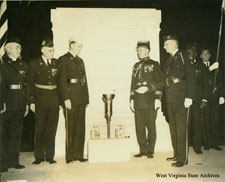
Lighting of the torch at the Tomb of the
Unknown Soldier at Arlington, November 3, 1938 |
On the 20th Anniversary of the Armistice, Stutler participated in lighting the torch or flambeau to honor the American soldiers who lost their lives in France during the war. The lighting ceremonies took place on November 4, 1938, at the Tomb of the Unknown Soldier in the Arlington Cemetery in Washington D.C. The torch, which symbolized the "eternal lights" of peace and amity, was sent to France to be relit at the location of the signing of the armistice, the Forest of Compiegne, and the location of the French unknown soldier, Arc de Triomph. Veterans, parents, widows, and orphans of veterans accompanied every lighted flambeau.6 Ironically, the lighting of these torches in the U.S. and France took place a year before the eve of World War II in 1939.7
|
"The 'flambeau' or torch was taken off the Steamer Paris by Boyd B. Stutler, . . . and conveyed to Arlington National Cemetery [for lighting at the Tomb of the Unknown Soldier] . . . . Assembled in Paris, all these lighted 'flambeaus', together with those from the allied countries, were taken November 11 to the Forest of Compiegne, the scene of the signing of the Armistice. There, an elaborate ceremony was held. . . . They were then brought to the Arc de Triomph here and relighted from the eternal light of the Tomb of the French Unknown Soldier." - American Legion press release, Boyd B. Stutler Collection |
|
A War Memorial was erected to commemorate the African American service in McDowell County, as 1,500 African American soldiers from the county served in World War I alone. The memorial was designed by architect Hassel T. Hicks of Welch and was dedicated in 1928. The two-story brick building is Classical Revival in style, with a massive two-story Roman Doric portico on the front fa ade. Serving as a social, recreational, and cultural center for black and white residents, the building was an important part of community life. The War Memorial in McDowell County was the first building in the country built to honor African Americans who fought in World War I.8
|
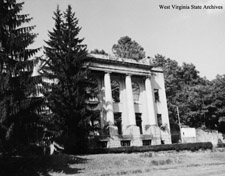
African American War Memorial, Kimball, 1998.
Jimmy J. Gianato Collection
|
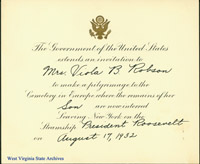
Invitation to Viola Robson
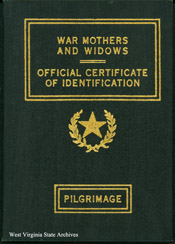
Certificate of ID
|

Viola's baggage ticket
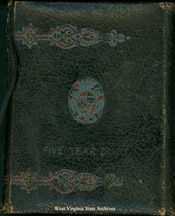
Excerpt from Viola's diary
|
Gold Star Mothers, also known as War Mothers, is an organization for mothers who lost a son or daughter in the service of our country. The organization was established in 1928.9 In 1933, Viola B. Robson, a resident of Charleston, went on pilgrimage to visit her son James P. Robson's grave in France. She had been continually corresponding with him from October of 1917 until he died in July 1918, but through this organization Viola Robson was given the opportunity to say goodbye to her son and to pay her respects to him.10 Today, the Gold Star Mothers is involved in putting on events to honor soldiers who have died in war on Veterans' Day and Memorial Day.11

Gold Star Mothers in France
|
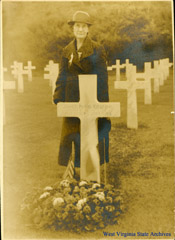
Viola B. Robson at son's grave
|

James Parks Robson
| |
All materials from the Viola B. Robson Collection |
The West Virginia Veterans Memorial was built in 1995 and is located on capitol grounds in Charleston. The memorial contains the names of men and women who died in World War I, World War II, Vietnam, or Korea. The West Virginia Veterans Memorial Commission carried out the initial work to research and identify men and women who should be included on the memorial. While it is not a requirement that their death occurred in combat, it must have occurred during the official period of conflict and prior to discharge from the military, in order to be placed on the memorial. Those whose names are on the memorial include soldiers born in West Virginia or state residents; who have lived in West Virginia six months prior to military service. More names were carved into the memorial at a later date through the efforts of Archives and History staff. In the World War I section alone, there are a total of 1,821 casualties.12
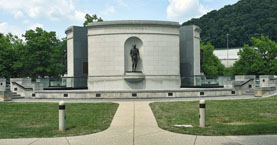
Veterans Memorial from the south, showing World War I statue
|

Veterans Memorial from the east
|
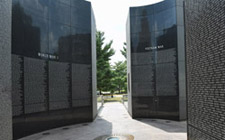
Interior of the Veterans Memorial, showing World War I names
|
Citations
1. Geiger Jr., Joseph. "Boyd Blynn Stutler: War Correspondent in the Pacific, 1944-1945." vol. XXV, No.2, West Virginia Historical Society (2011). 1-2. Web, http://www.wvculture.org/history/wvhs/wvhs2502.pdf. Accessed 12 June 2017.
2. Miller, William. "Boyd Stutler, Unsung Hero of the Legion, Heads Magazine." Charleston Daily Mail, August 30, 1953, in MS 78-1, Boyd B. Stutler Collection, Supplemental Box 2, Boyd Stutler Folder, West Virginia State Archives.
3. American Heritage . Dictionary of the English Language. Fifth Edition. S.v. "Red Cross." Web, http://www.thefreedictionary.com/Red+Cross. Accessed June 12, 2017.
4. American Legion. Dictionary.com. Dictionary.com Unabridged. Random House, Inc. Web, http://www.dictionary.com/browse/american-legion. Accessed 12 June 2017.
5. "People & Events: John Brown, 1800-1859" Public Broadcasting Online. Web, http://www.pbs.org/wgbh/aia/part4/4p1550.html. Accessed 12 June 2017.
6. American Legion Press Release. 10 November 1938, in Boyd B. Stutler Collection.
7. "World War II History." The History Channel. Web. http://www.history.com/topics/world-war-ii/world-war-ii-history. Accessed 31 July 2017.
8. Stafford, Margo. "Kimball War Memorial." West Virginia Encyclopedia, 2016-2017, Web, http://www.wvencyclopedia.org/print/Article/1206. Accessed 29 May 2017.
9. "We honor through service." American Gold Star Mothers, Inc. Web, http://www.goldstarmoms.com/index.htm. Accessed 17 July 2017.
10. Viola B. Robson Collection, Ms 2009-152, folder Correspondence James Robson to Viola B. Robson 1917-1918 and folder photos, West Virginia State Archives.
11. "We honor through service."
12. "West Virginia Veterans Memorial Database." West Virginia Archives and History. Web, http://www.wvculture.org/history/wvmemory/wvvetmem.html. Accessed on 17 July 2017.
|



